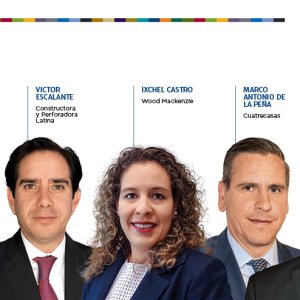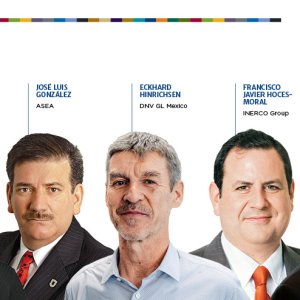
PEMEX’s New Procurement Model & the Future of Local Content
Moderator: César Vera, Region Manager of GE Oil & Gas and Surface PC Latin America
Panelist: Arturo Henríquez, Chief Procurement Officer of PEMEX
Panelist: Hugo Espinosa, Vice-President Mexico and Central America Geomarket of Baker Hughes
Panelist: Héctor Márquez, Head of the Procurement Unit at the Ministry of Economy
Panelist: José Luis Pérez Meseguer, Project Leader and Coordinator at UTCAM
The panel began with a presentation by Arturo Henriquez, who wanted to give the audience an idea of the magnitude of PEMEX’s procurement operations. “PEMEX spends close to US$30-40 billion in procurement. This number is even larger than the NOC’s budget because the expenses are spread out throughout many years,” he explained, adding that PEMEX signed an average of 300,000 contracts in the 2012-2013 periods. Henríquez talked about PEMEX’s new procurement model, which is based on three axes: strategic sourcing and category management, strategic business procurement, and suppliers. “The Procurement Division was created in 2014 and has resulted in US$6.2 billion savings by implementing strategic sourcing.” He told the audience that procurement was historically focused on low prices, but the new model emphasizes elements such as quality, availability of spare parts, maintenance, etc. to avoid unnecessary long-term expenses. Finally, the relationship between PEMEX and its suppliers was mainly transactional. Now, as a result of the supplier base, PEMEX can establish long-term relationships, while gaining a deeper understanding of what each supplier offers.
César Vera proceeded to ask Hugo Espinosa how the private sector has reacted to PEMEX’s new procurement model. The Baker Hughes representative responded by admitting that his company has implemented a similar model. “Our new approach to procurement has eliminated redundancies that were preventing us from taking advantage of economies of scale. Now we know our suppliers better, and our relationship with PEMEX has improved as well.”
The microphone went to Pérez Meseguer, who told that UTCAM has been working for PEMEX for ten years under the public entity legal figure. “UTCAM students started working in the oil industry due to the university’s location. Then we saw an opportunity to provide training and system development services to PEMEX E&P.” He said that the impact of the drop in oil prices can be felt across PEMEX’s supply chain, thus the university is looking for ways to diversify. An option is to cater to the new players that will arrive in Mexico soon. For this purpose, UTCAM has opened offices across Mexico’s oil and gas states and an office in Houston to offer services to IOCs.
Márquez, who was representing the Ministry of Economy, talked about how his division is in charge of developing a methodology to measure local content inclusion in the oil and gas sector. “We opted for a neutral and unbiased methodology that would acknowledge different activities. The Ministry of Economy is looking at the consumption of national goods and services –labor- that a contractor used. We noticed that ‘services’ was an ambiguous and confusing term that distorted metrics, so we decided to go down the production chain.” Given the law’s emphasis on closing gaps in technology and training, the Ministry decided to include concepts such as training expenses, technology transfers, and even investments on innovation and new developments as ‘local content consumption’.
Vera then asked Henríquez how PEMEX integrates the local content requirements. The chief of procurement claimed local content is not new to PEMEX, and in fact, the NOC collaborated with the Ministry of Economy in defining local content rules, which apply to upstream only and are valid throughout the working life of a well. “Now that PEMEX has to create value, the focus is not to strengthen national content as a government entity, but as another player abiding to the rules. We look for ways to benefit local suppliers in a way that benefits PEMEX as well, forcing us to look for support schemes in our procurement.”
Espinosa asserted that the Mexican industry is comprised of local professionals and technicians even in the case of international companies like Baker Hughes. He claimed new procurement models and the entry of new companies will diversify the supply chain and force players to find their niche. “We will have to fight the large companies, but will also learn about smaller markets. Small operators will provide opportunities for suppliers and will give them the needed experience to grow.”














